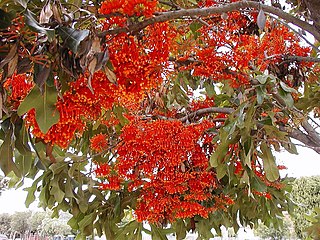
Araucaria is a genus of evergreen coniferous trees in the family Araucariaceae. There are 20 extant species in New Caledonia, Norfolk Island, eastern Australia, New Guinea, Papua (Indonesia), Argentina, Chile, Brazil, and Paraguay.
The taxonomy of the Orchidaceae has evolved slowly during the last 250 years, starting with Carl Linnaeus who in 1753 recognized eight genera. De Jussieu recognized the Orchidaceae as a separate family in his Genera Plantarum in 1789. Olof Swartz recognized 25 genera in 1800. Louis Claude Richard provided us in 1817 with the descriptive terminology of the orchids.. The next step was taken in 1830-1840 by John Lindley, who recognized four subfamilies. He is generally recognized as the father of orchid taxonomy. The next important step was taken by George Bentham with a new classification, recognizing subtribes for the first time. This classification was first presented in a paper that Bentham read to the Royal Society in 1881. Then it was published in 1883 in the final volume of Genera Plantarum. The next great contributors were Pfitzer (1887), Schlechter (1926), Mansfeld (1937), Dressler and Dodson (1960), Garay, Vermeulen (1966), again Dressler (1981). and Burns-Balogh and Funk (1986). Dressler's 1993 book had considerable influence on later work.

Vanilloideae is one of the subfamilies of orchids belonging to the large family Orchidaceae.

Eriaxis is a monotypic genus of orchids belonging to the subfamily Vanilloideae. The sole species is Eriaxis rigida, endemic to New Caledonia. Its closest relative is Clematepistephium, also endemic to New Caledonia.

Lecanorchis is a genus of orchids belonging to the subfamily Vanilloideae.

Stenocarpus is a genus of about 25 species of woody trees or shrubs, constituting part of the plant family Proteaceae.
Triunia is a genus of medium to tall shrubs or small trees found as understorey plants in rainforests of eastern Australia. Members of the plant family Proteaceae, they are notable for their poisonous fleshy fruits or drupes. Only one species, T. youngiana, is commonly seen in cultivation.

Cyphophoenix is a genus of flowering plant in the family Arecaceae. It contains 4 known species, all endemic to New Caledonia:. The relationships between Cyphophoenix and some other genera of the tribe Basseliniinae including Physokentia and the New Caledonia endemic Burretiokentia are not clear.

Kermadecia is a genus of flowering plants in the family Proteaceae. The genus comprises five species, all endemic to New Caledonia. Its closest relatives are Sleumerodendron and Turrillia, of which the species have once been placed in Kermadecia.
Arthroclianthus is a genus of flowering plants in the legume family, Fabaceae. It belongs to the subfamily Faboideae. Its c. 19 species are all endemic to New Caledonia. Its closest relatives include Nephrodesmus, also endemic to New Caledonia, Ohwia and Hanslia.
Nephrodesmus is a genus of flowering plants in the legume family, Fabaceae. It belongs to the subfamily Faboideae. It contains c. 5 species, all endemic to New Caledonia. Its closest relatives is Arthroclianthus, also endemic to New Caledonia and their distinction has been challenged.
Virotia is a genus of six species of flowering plants in the family Proteaceae. The genus is endemic to New Caledonia with six species that were once placed in Macadamia. Its closest relatives are the Australian Athertonia and the Asian Heliciopsis. The genus is named after Robert Virot, pioneer of ecological studies in New Caledonia and author of a monograph of New Caledonian Proteaceae.
Clematepistephium is a genus of flowering plants from the orchid family, Orchidaceae. It contains only one known species, Clematepistephium smilacifolium, endemic to the island of New Caledonia. Its closest relative is Eriaxis, also endemic to New Caledonia.

Vanilla polylepis is a climbing orchid species in the plant family Orchidaceae. It is native to tropical Africa, with a range spanning the width of the continent, from Kenya to Angola. It grows in high-altitude evergreen and swamp forests between 1,200–1,500 m (3,900–4,900 ft) and is often found growing on trees bordering rivers and waterfalls. Plants produce bright green, fleshy stems, 10–12 mm (0.39–0.47 in) in diameter, with large, glossy leaves. White, aerial roots form on the stems allowing the orchids to attach themselves to trees for support. As with many orchids, they produce showy flowers, which in the case of V. polylepis are white and yellow with a pink to maroon blotch. This differentiates them from similar species. They have seedpod-like fruits, called capsules, which produce a distinctive aroma as they dry. They are closely related to the well-known species Vanilla planifolia, whose seed pods are used commercially in the production of vanilla flavouring.

The Tryonicidae are a family of cockroaches.
Eucarpha is a genus of flowering plant of the family Proteaceae, endemic to New Caledonia. Two species are recognised. Up until 1975, these were classified within the genus Knightia until Lawrie Johnson and Barbara G. Briggs recognised their distinctness, particularly their prominent bracts, in their 1975 monograph "On the Proteaceae: the evolution and classification of a southern family". As of today, the nomenclatural combinations for these two species in the genus Eucarpha have not been published.
Sleumerodendron is a monotypic genus of plant in the family Proteaceae. The sole species is Sleumerodendron austrocaledonicum.
Turrillia is a genus of plants in the family Proteaceae, native to Oceania.
Moutabea pacifica, synonym Balgoya pacifica, is a species of vine in the family Polygalaceae. It is endemic to New Caledonia. It has been considered to be the only species of the genus Balgoya. It is now placed in the neotropical genus Moutabea, in the tribe Moutabeae.

Pseudovanilla foliata, commonly known as the great climbing orchid, is a plant in the orchid family native to Queensland, New South Wales, and New Guinea. It is a terrestrial orchid with a vining vegetative habit, climbing by means of adventitious roots produced at nodes. Its leaves are reduced, and the species is considered to be at least partially mycoheterotrophic.










